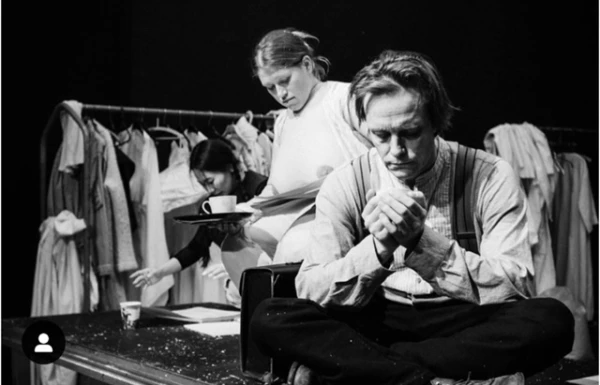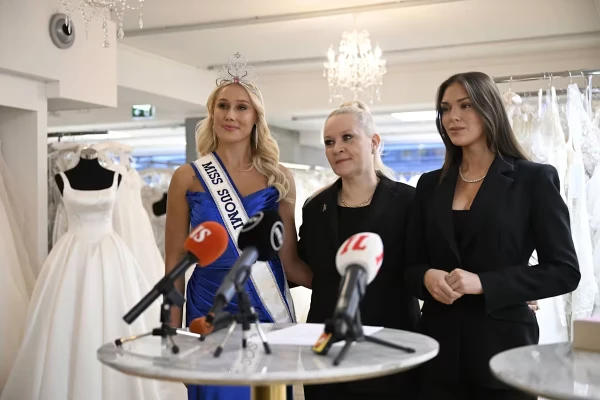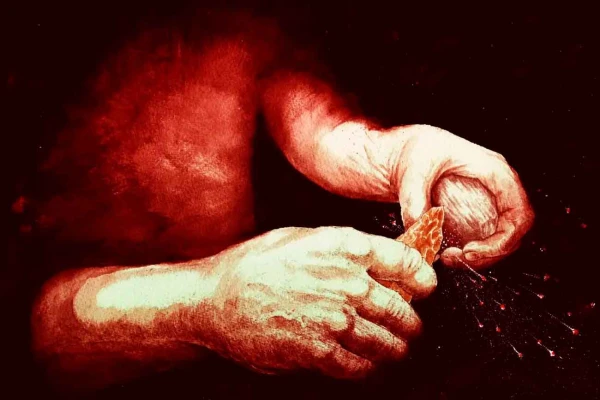
The folk melodic tradition in the play coexists with contemporary sound experiments.
The premiere of Kirill Serebrennikov's play "The Blizzard" became not only the main event at the Salzburg Festival 2025 but also a significant socio-philosophical statement on the theme of "East-West." Based on the story by Vladimir Sorokin, this parable transformed into a multimedia journey where chaos and order, death and life, Russia and Europe converge.
The plot is based on phantasmagorical travel notes in which literary traditions intertwine with contemporary journalistic realities. In the revised version of the story by K. Serebrennikov, archetypal characters serve as guiding milestones in understanding the history of the relationship between the Russian element and Western European order.
At the center of the narrative are two characters: the German Doctor Garin and his Russian coachman Perkhusha. Garin is obsessed with a medical mission: he must deliver a vaccine to the residents of a distant village, whom a terrible virus is turning into zombies. Perkhusha is a bread delivery man who learned German under duress and loves his miniature horses with abandon. At first, the horses appear on "the altar of Her Majesty the Blizzard," under which Perkhusha sleeps, wrapped in a rough cloth. One horse even runs into the audience, and Perkhusha has to catch it, stepping over the spectators sitting in the front rows. During such simple tricks, it is hard to imagine that this amateurish foolishness of a children's morning performance will unfold into a full-scale reflection on the dualism of morality and ethics in a couple of hours.
The road, which becomes the main place of transformation from childish jokes into profound worldview revelations, is full of trials: micro-horses harnessed to a whimsical "scooter-mobile" run into the narcotic crystals of steppe drug dealers, crash into the nostril of a giant laborer frozen in drunken stupor in the steppe, freeze at the howl of hungry wolves, and dissolve in the word "stupor," which at the Proto-Slavic etymological level is close in meaning to the word "blizzard" ("narcotic, dust, flour").
The blizzard itself in K. Serebrennikov's dramatic version becomes not a disaster that, in V. Sorokin's words, tears off a person's "skin of civilization," but a personified ritual. The blizzard recites and sings, dances and grows in video installations, bursts into flames and melts in shadows. It trustingly addresses the child's subconscious of the viewer and unpacks a multi-layered catalog of associations in their memory.
It is no coincidence that the scenography of the play grows from the image of the main Christmas souvenir — a glass sphere, inside which snowflakes endlessly swirl. This symbol of the captured element immerses the viewer in a closed world of illusions from which there is no escape, where only the coexistence of the figures, houses, Christmas trees, and animals trapped inside is possible.
The stage space created by the director in collaboration with Vlad Ogay gains tangibility in the video mirages of Ilya Shagalov, the acoustic topography of the blizzard by Vyacheslav Kasyanov, and the lighting design by Sergey Kuchar. The video broadcasts by Frol Podlesny blur the boundaries between the physical bodies of the actors and their images.
The multifaceted Blizzard, performed by Sonya Baisvenger, Yan Ge, Varvara Shmykova Belendzhva, Peter, Slava Serdyuchenko, Mikhail Polyakov, and Klaudius Steffens, acts as a fate-weaver — a majestic and merciless ancient "snow chorus." In the choreography of Evgeny Kulagin and Ivan Yestegneyev, each participant retains their individuality, but in the relentless whirl of the narrative, they merge into the polyphony of the Blizzard, which smiles, grimaces, entertains, and frightens with a multitude of virtuously created masks.
In the brilliant acting ensemble, I would like to highlight the work of Varvara Shmykova, who rethought and embodied in several roles the archetype of fatal femininity. The actress brilliantly plays the caricatured seductive physicality in the image of the miller's mistress, easily dances a tap in Doctor Garin's dream, and is elegantly irresistible in the image of the Snow Queen-killer, gently lullabying the freezing Perkhusha. In these faces of the Blizzard, maternal and demonic, erotic and deadly, are united.
A standout performance in the play was by Chinese actress, singer, graduate of the Moscow Institute of Cinematography, and world-renowned model Yan Ge. In addition to her snowy etudes in the personified image of the Blizzard, Yan Ge voiced the caricatured role of the puppet henpecked Miller — an unfortunate man embittered at the whole world.
The steel unyieldingness of death itself rises before us in the work of German actress Sonya Baisvenger, who has become the embodiment of the frightening forces of nature, crystallizing in the hypnotic three-dimensionality of the play — theatrical stage, cinema, and video.
The colorful musical fabric of the production is an independent layer of action, equal in significance to the acting, light, and video. Composer Alexander Manotskov created a score that combines electronic vibrations, instrumental solos, multi-genre vocals, and silence. The score has no rigid stylistic hierarchy: folk melodic tradition coexists with contemporary sound experiments, fragments of prayer intertwine with industrial noise, and the melody melts into the acoustic haze of special effects. All this diversity is gathered into a single organism by the musical director of the production, Daniil Orlov.
The live presence on stage of Malika Maminova and Mikhail Polyakov visualizes this complex sound layer, in which the figures of the musicians become independent elements of the plastic dramaturgy.
The main dramatic nerve of the play is the duet-duel between Doctor Garin and his coachman Perkhusha.
August Dill, known to Russian-speaking audiences for his role as Woland in M. Lokshin's film "Master and Margarita" (2024) and in Serebrennikov's film about the Nazi criminal Mengele, guides his character, the German Garin, along the path from "European" self-confidence and civilizational arrogance to the ability to hear and understand the wayward Russian "idiot Perkhusha."













